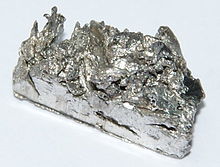
Ytterbium

Ytterbium is a chemical element with the symbol Yb and atomic number 70. It is the fourteenth and penultimate element in the lanthanide series, which is the basis of the relative stability of its +2 oxidation state. However, like the other lanthanides, its most common oxidation state is +3, as in its oxide, halides, and other compounds. In aqueous solution, like compounds of other late lanthanides, soluble ytterbium compounds form complexes with nine water molecules. Because of its closed-shell electron configuration, its density and melting and boiling points differ significantly from those of most other lanthanides. Ytterbium is a chemical element with the symbol Yb and atomic number 70. It is the fourteenth and penultimate element in the lanthanide series, which is the basis of the relative stability of its +2 oxidation state. However, like the other lanthanides, its most common oxidation state is +3, as in its oxide, halides, and other compounds. In aqueous solution, like compounds of other late lanthanides, soluble ytterbium compounds form complexes with nine water molecules. Because of its closed-shell electron configuration, its density and melting and boiling points differ significantly from those of most other lanthanides. In 1878, the Swiss chemist Jean Charles Galissard de Marignac separated from the rare earth 'erbia' another independent component, which he called 'ytterbia', for Ytterby, the village in Sweden near where he found the new component of erbium. He suspected that ytterbia was a compound of a new element that he called 'ytterbium' (in total, four elements were named after the village, the others being yttrium, terbium and erbium). In 1907, the new earth 'lutecia' was separated from ytterbia, from which the element 'lutecium' (now lutetium) was extracted by Georges Urbain, Carl Auer von Welsbach, and Charles James. After some discussion, Marignac's name 'ytterbium' was retained. A relatively pure sample of the metal was not obtained until 1953. At present, ytterbium is mainly used as a dopant of stainless steel or active laser media, and less often as a gamma ray source. Natural ytterbium is a mixture of seven stable isotopes, which altogether are present at concentrations of 3 parts per million. This element is mined in China, the United States, Brazil, and India in form of the minerals monazite, euxenite, and xenotime. The ytterbium concentration is low because it is found only among many other rare earth elements; moreover, it is among the least abundant. Once extracted and prepared, ytterbium is somewhat hazardous as an eye and skin irritant. The metal is a fire and explosion hazard. Ytterbium is a soft, malleable and ductile chemical element that displays a bright silvery luster when pure. It is a rare earth element, and it is readily dissolved by the strong mineral acids. It reacts slowly with cold water and it oxidizes slowly in air. Ytterbium has three allotropes labeled by the Greek letters alpha, beta and gamma; their transformation temperatures are −13 °C and 795 °C, although the exact transformation temperature depends on the pressure and stress. The beta allotrope (6.966 g/cm3) exists at room temperature, and it has a face-centered cubic crystal structure. The high-temperature gamma allotrope (6.57 g/cm3) has a body-centered cubic crystalline structure. The alpha allotrope (6.903 g/cm3) has a hexagonal crystalline structure and is stable at low temperatures. The beta allotrope has a metallic electrical conductivity at normal atmospheric pressure, but it becomes a semiconductor when exposed to a pressure of about 16,000 atmospheres (1.6 GPa). Its electrical resistivity increases ten times upon compression to 39,000 atmospheres (3.9 GPa), but then drops to about 10% of its room-temperature resistivity at about 40,000 atm (4.0 GPa). In contrast with the other rare-earth metals, which usually have antiferromagnetic and/or ferromagnetic properties at low temperatures, ytterbium is paramagnetic at temperatures above 1.0 kelvin. However, the alpha allotrope is diamagnetic. With a melting point of 824 °C and a boiling point of 1196 °C, ytterbium has the smallest liquid range of all the metals. Contrary to most other lanthanides, which have a close-packed hexagonal lattice, ytterbium crystallizes in the face-centered cubic system. Ytterbium has a density of 6.973 g/cm3, which is significantly lower than those of the neighboring lanthanides, thulium (9.32 g/cm3) and lutetium (9.841 g/cm3). Its melting and boiling points are also significantly lower than those of thulium and lutetium. This is due to the closed-shell electron configuration of ytterbium ( 4f14 6s2), which causes only the two 6s electrons to be available for metallic bonding (in contrast to the other lanthanides where three electrons are available) and increases ytterbium's metallic radius. Ytterbium metal tarnishes slowly in air. Finely dispersed ytterbium readily oxidizes in air and under oxygen. Mixtures of powdered ytterbium with polytetrafluoroethylene or hexachloroethane burn with a luminous emerald-green flame. Ytterbium reacts with hydrogen to form various non-stoichiometric hydrides. Ytterbium dissolves slowly in water, but quickly in acids, liberating hydrogen gas. Ytterbium is quite electropositive, and it reacts slowly with cold water and quite quickly with hot water to form ytterbium(III) hydroxide:
